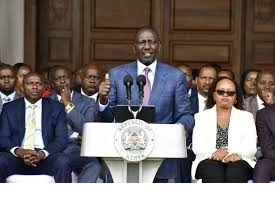As Kenya approaches 2025, political dynamics continue to evolve, making it essential for citizens to understand the leadership styles of their leaders. One leader who has garnered significant attention is William Ruto, the current President. Ruto’s leadership style has become a subject of debate and analysis. This article delves into Ruto’s leadership style, exploring its implications for the country as we enter a new political era.
Table of Contents
- Overview of Ruto’s Leadership Style
- Key Attributes of Ruto’s Leadership Style
- Ruto’s Political Strategy
- Public Perception of Ruto’s Leadership
- Challenges Facing Ruto’s Leadership Style
- Future Implications of Ruto’s Leadership Style
Overview of Ruto’s Leadership Style
Ruto’s leadership style is characterized by a combination of populism and pragmatic governance. It draws both praise and criticism. His rise to power has been marked by significant accomplishments as well as notable challenges. Understanding the nuances of Ruto’s leadership style is vital for predicting future political developments in Kenya.
Key Attributes of Ruto’s Leadership Style
Several key attributes define Ruto’s leadership style:
- Populist Approach: Ruto has effectively utilized a populist approach to connect with ordinary citizens. His grassroots initiatives have resonated well with many Kenyans, particularly in rural areas.
- Strong Communication Skills: Ruto’s oratory skills have played a significant role in his political journey. His ability to communicate complex issues in a relatable manner has helped him build a loyal support base.
- Pragmatism: Ruto is a pragmatist who focuses on finding practical solutions to Kenya’s pressing issues, such as poverty, youth unemployment, and infrastructure development.
- Coalition Building: Ruto has shown strength in coalition building, forging partnerships with various political factions, which has been crucial in his political ascent.
Ruto’s Political Strategy
At the heart of Ruto’s political strategy is the idea that genuine leadership requires engaging with citizens at every level. Ruto’s leadership style emphasizes several strategic elements:
- Mobilization of Grassroots Support: Ruto has consistently focused on grassroots mobilization, aiming to empower locals while making them stakeholders in national development. This approach has reinforced his popularity in areas that feel neglected by traditional political elites.
- Strategic Alliances: Recognizing the power of alliances, Ruto has proficiently navigated Kenya’s complex political landscape, including forming coalitions that amplify his political narrative.
- Public Engagement: Ruto frequently engages with the public through town hall meetings and direct communication, ensuring that he remains in touch with their needs and concerns. This is a central aspect of Ruto’s leadership style.
Public Perception of Ruto’s Leadership
The perception of Ruto’s leadership style is complex and multifaceted. Since his ascension, different segments of the population have reacted differently:
- Support from Rural Voters: Many rural Kenyans appreciate Ruto’s focus on local issues and his commitment to uplifting marginalized communities, leading to a significant following.
- Criticism from Urban Voters: Some urban residents express skepticism, critiquing his policies as being too populist without addressing systemic challenges. Critics argue that while his grassroots initiatives are commendable, they often lack sustainability.
Challenges Facing Ruto’s Leadership Style
While Ruto’s leadership style possesses several strengths, it also faces considerable challenges:
- Addressing Corruption: Corruption remains a pervasive problem in Kenyan politics. Ruto’s ability to combat this issue is central to his leadership credibility.
- Unity Among Diverse Populations: Kenya’s diverse ethnic landscape poses potential risks for unity under Ruto’s leadership. Ensuring inclusivity while maintaining his political base will be crucial.
Future Implications of Ruto’s Leadership Style
Looking toward 2025, Ruto’s leadership style will likely continue to shape Kenya’s political landscape. Several implications emerge:
- Evolving Political Landscape: As more young people engage in the political process, Ruto may need to adapt his leadership style to resonate with the aspirations of this demographic.
- Potential for Policy Reinvention: Ruto’s pragmatic approach may allow for greater policy experimentation, particularly in addressing pressing issues like economic disparity and climate change.
In conclusion, understanding Ruto’s leadership style is essential as Kenyans navigate the political climate leading up to the 2025 elections. His unique blend of populism, pragmatism, and strong communication skills, combined with the challenges he faces, will undoubtedly influence the future of Kenya. By critically analyzing Ruto’s leadership style, citizens can better comprehend their roles in shaping the nation’s political narrative.


